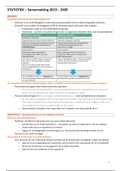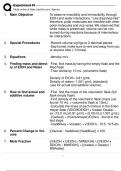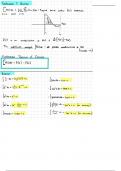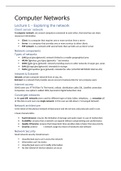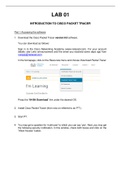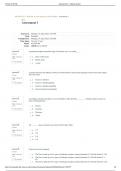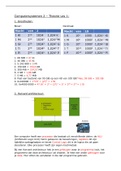Computer networks
Lecture 1 – Exploring The Network
Client Server Network
A computer network consists of several computers that are connected to each other. That way they
can share resources and information with each other.
A computer in a network is called a host/ end device
• Server: is a computer that provides one or more services to other computers.
• Client: is a computer that requires one or more services from a server.
P2P Net work
A network that consists of hosts can also act as both client and server. That is called peer-to-peer
network.
Network Components
A network infrastructure consists of:
• 2 types of hardware components:
o Network devices
▪ End devices/ hosts
▪ Intermediary devices
o Network media
▪ Wireless media
▪ Wired media
• 1 type of software component
o Services
▪ Ex. Web, e-mail services
Network Devices
Two types of network devices:
▪ A end device/ host is the source or destination of messages sent over the network. They can
be reached from an address.
o Ex. Computers, tablets, smartphones, printers, voIP phones, etc.
▪ An intermediary device is a device that provides the connection of end devices. Such
devices connect hosts to the network and connects networks with each other.
o Ex. AP’s (Access Points), switches, routers, firewalls, etc.
Network media
A network uses the following media:
▪ Wired media
o Cables transmitting data in the from of electrical signals over metal wires – UTP/STP
o Cables transmitting data in the from of light signals over fiber optic fibers - glasvezel
▪ Wireless media
o Electromagnetic waves: Wi-Fi, Bluetooth, satellite, etc.
Choice of medium depends on: distance, environment, speed, cost of the medium, etc.
1
,Types Of Networks
Layout based on the size of the area covered by the network
▪ LAN (Local Area Network): network limited to a small geographical area
▪ WLAN (Wireless Local Area Network): but wireless
▪ WAN (Wide Area Network): network providing access to other networks in large geo. Areas
▪ SAN (Storage Area Network): intended for data storage
▪ MAN (Metropolitan Area Network): network located in terms of size between LAN & WAN
LAN: usually managed by a local network administrator – provides higher speeds than WAN
WAN: usually managed by an ISP (Internet Service Provider)
Internet
The internet is a global set of networks connected to each other, using a number of commonly used
standards for commuNIation.
Internet is not in the hands of a person or a group, but there are several international institutions
that develop standards for protocols and processes used on the internet.
Intranet And Extranet
Intranet: consists of a connection of LANs and WANs that belongs to
an organization or company and is designed so that it can only be
used by people within that org.
Extranet: is a network that provides secure access to business data
for non-company users
Internet Access
Internet connection between home/office and the ISP = “the last mile”
SOHO Users
usually use on of the following connections for internet access:
▪ The distribution cable
▪ DSL (Digital Subscriber Line)
▪ Cellular connection
▪ Satellite connection
▪ FTTH (Fiber To The Home)
Companies
the following options are added:
▪ SDSL (Symmetric Digital Subscriber Line)- same as DSL but higher uploads and downl. speeds
Converged Networks
In the past, separate networks were provided for different types of data (computer date, telephony
data, video, etc.).
Nowadays all data is sent over a single network. In this case, one speaks of a converged network.
This makes subscription possible for multiple services.
• “Triple pay”: telephone television, internet & mobile
2
,Network Architecture
Network architecture means the whole of the physical network infrastructure and the network
services and protocols used in a network communication.
The 4 basic characteristics:
Fault Tolerance
Ensures the limitation of damage and quick repair in case of a malfunction
Scalability
Ensures that a network can expand without compromising user performance
Quality of Service
Ensures that time-sensitive data (streaming or audio) or important business data can be delivered
faster than low priority data (web pages).
Security
Protects network usage by means of hardware and software
Network Security
Good network security should ensure that:
• Unauthorised users do not have access to the network
• Information cannot be stolen
• Unauthorised users cannot modify information
• No DoS (Denial of Service) attacks can occur
The three main security principles that can be used for this are: CIA
• Confidentiality: Can be done via authentication and encryption
• Integrity: Can be ensured by using the Public Key that works with certificates
• Availability: Can be done, among others things, firewalls, antivirus, redundancy
3
, Lecture 2 – NOS Configuration
Introduction
Like end devices, intermediary devices such as switches and routers are equipped with an operating
system. In this case, one speaks of a NOS (Network Operating System). Cisco’s NOS is called IOS
(Internetwork Operating System). – usually operated via a CLI. The OS of home routers is often
referred to as ‘firmware’ and is usually operated via a web-based GUI (Graphical User Interface).
The IOS is stored in flash memory and is copied to the RAM upon booting of most devices.
With IOS, you can take care of:
• Network security
• Configuration of ports and interfaces
• Routing
• QoS
Access To The CLI
You can access the IOS CLI of a Cisco device in various ways from a computer:
1. Locally via a dedicated console port – serial connection
2. Remotely via Telnet – not secure
3. Remotely via SSH (Secure shell)
Remote access:
• If the computer is not connected directly but via intermediary devices.
• Is only possible if the network functions of the device function correctly.
Local access via the console port:
• Only for device management
• Connection computer console port via a special cable and use of special software
• Is mainly used for initial configuration
• Can also be used if there is no network connectivity
Cisco Rollover Cable
Cisco also uses a Cisco-specific “rollover cable” to connect a computer to the console port of a router
or switch. Therefore, it is also known as ‘console cable’.
Same principle as how you connected your laptop to the Raspberry Pi in the HDOS module (e.g. use
‘Putty’ op COM port) but using other connectors.
This is a serial connection, no network connection
4
Lecture 1 – Exploring The Network
Client Server Network
A computer network consists of several computers that are connected to each other. That way they
can share resources and information with each other.
A computer in a network is called a host/ end device
• Server: is a computer that provides one or more services to other computers.
• Client: is a computer that requires one or more services from a server.
P2P Net work
A network that consists of hosts can also act as both client and server. That is called peer-to-peer
network.
Network Components
A network infrastructure consists of:
• 2 types of hardware components:
o Network devices
▪ End devices/ hosts
▪ Intermediary devices
o Network media
▪ Wireless media
▪ Wired media
• 1 type of software component
o Services
▪ Ex. Web, e-mail services
Network Devices
Two types of network devices:
▪ A end device/ host is the source or destination of messages sent over the network. They can
be reached from an address.
o Ex. Computers, tablets, smartphones, printers, voIP phones, etc.
▪ An intermediary device is a device that provides the connection of end devices. Such
devices connect hosts to the network and connects networks with each other.
o Ex. AP’s (Access Points), switches, routers, firewalls, etc.
Network media
A network uses the following media:
▪ Wired media
o Cables transmitting data in the from of electrical signals over metal wires – UTP/STP
o Cables transmitting data in the from of light signals over fiber optic fibers - glasvezel
▪ Wireless media
o Electromagnetic waves: Wi-Fi, Bluetooth, satellite, etc.
Choice of medium depends on: distance, environment, speed, cost of the medium, etc.
1
,Types Of Networks
Layout based on the size of the area covered by the network
▪ LAN (Local Area Network): network limited to a small geographical area
▪ WLAN (Wireless Local Area Network): but wireless
▪ WAN (Wide Area Network): network providing access to other networks in large geo. Areas
▪ SAN (Storage Area Network): intended for data storage
▪ MAN (Metropolitan Area Network): network located in terms of size between LAN & WAN
LAN: usually managed by a local network administrator – provides higher speeds than WAN
WAN: usually managed by an ISP (Internet Service Provider)
Internet
The internet is a global set of networks connected to each other, using a number of commonly used
standards for commuNIation.
Internet is not in the hands of a person or a group, but there are several international institutions
that develop standards for protocols and processes used on the internet.
Intranet And Extranet
Intranet: consists of a connection of LANs and WANs that belongs to
an organization or company and is designed so that it can only be
used by people within that org.
Extranet: is a network that provides secure access to business data
for non-company users
Internet Access
Internet connection between home/office and the ISP = “the last mile”
SOHO Users
usually use on of the following connections for internet access:
▪ The distribution cable
▪ DSL (Digital Subscriber Line)
▪ Cellular connection
▪ Satellite connection
▪ FTTH (Fiber To The Home)
Companies
the following options are added:
▪ SDSL (Symmetric Digital Subscriber Line)- same as DSL but higher uploads and downl. speeds
Converged Networks
In the past, separate networks were provided for different types of data (computer date, telephony
data, video, etc.).
Nowadays all data is sent over a single network. In this case, one speaks of a converged network.
This makes subscription possible for multiple services.
• “Triple pay”: telephone television, internet & mobile
2
,Network Architecture
Network architecture means the whole of the physical network infrastructure and the network
services and protocols used in a network communication.
The 4 basic characteristics:
Fault Tolerance
Ensures the limitation of damage and quick repair in case of a malfunction
Scalability
Ensures that a network can expand without compromising user performance
Quality of Service
Ensures that time-sensitive data (streaming or audio) or important business data can be delivered
faster than low priority data (web pages).
Security
Protects network usage by means of hardware and software
Network Security
Good network security should ensure that:
• Unauthorised users do not have access to the network
• Information cannot be stolen
• Unauthorised users cannot modify information
• No DoS (Denial of Service) attacks can occur
The three main security principles that can be used for this are: CIA
• Confidentiality: Can be done via authentication and encryption
• Integrity: Can be ensured by using the Public Key that works with certificates
• Availability: Can be done, among others things, firewalls, antivirus, redundancy
3
, Lecture 2 – NOS Configuration
Introduction
Like end devices, intermediary devices such as switches and routers are equipped with an operating
system. In this case, one speaks of a NOS (Network Operating System). Cisco’s NOS is called IOS
(Internetwork Operating System). – usually operated via a CLI. The OS of home routers is often
referred to as ‘firmware’ and is usually operated via a web-based GUI (Graphical User Interface).
The IOS is stored in flash memory and is copied to the RAM upon booting of most devices.
With IOS, you can take care of:
• Network security
• Configuration of ports and interfaces
• Routing
• QoS
Access To The CLI
You can access the IOS CLI of a Cisco device in various ways from a computer:
1. Locally via a dedicated console port – serial connection
2. Remotely via Telnet – not secure
3. Remotely via SSH (Secure shell)
Remote access:
• If the computer is not connected directly but via intermediary devices.
• Is only possible if the network functions of the device function correctly.
Local access via the console port:
• Only for device management
• Connection computer console port via a special cable and use of special software
• Is mainly used for initial configuration
• Can also be used if there is no network connectivity
Cisco Rollover Cable
Cisco also uses a Cisco-specific “rollover cable” to connect a computer to the console port of a router
or switch. Therefore, it is also known as ‘console cable’.
Same principle as how you connected your laptop to the Raspberry Pi in the HDOS module (e.g. use
‘Putty’ op COM port) but using other connectors.
This is a serial connection, no network connection
4




